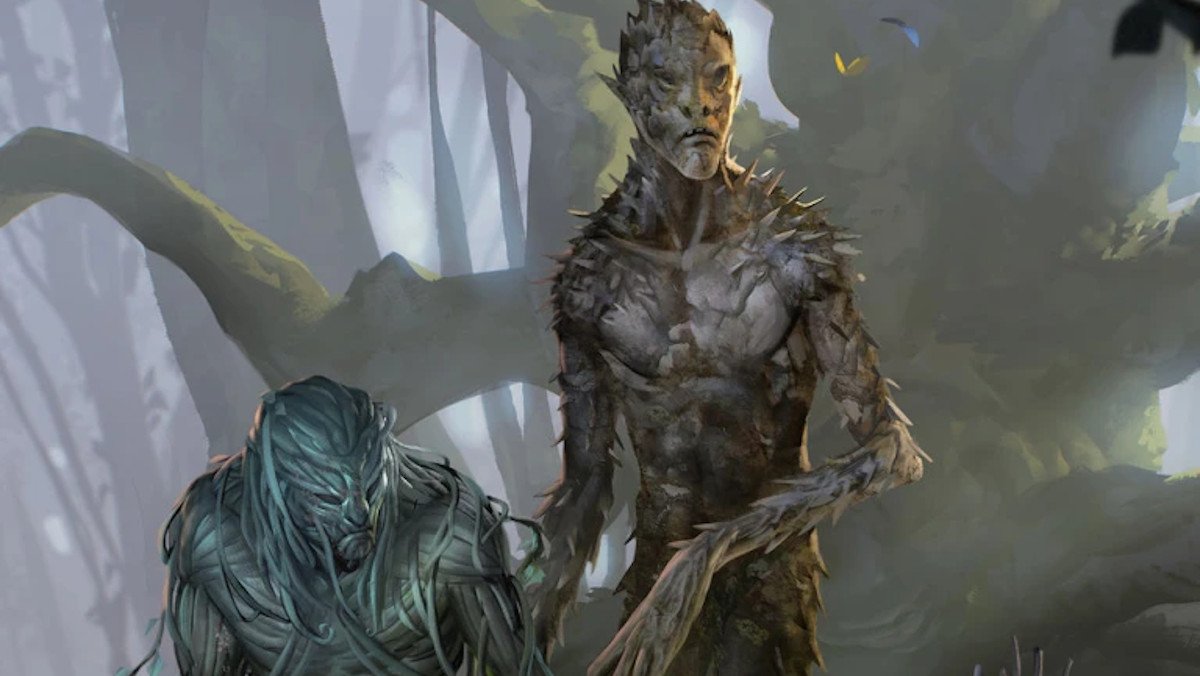
Creating an entire campaign story arc for your Dungeons & Dragons players can be a monumental task. It requires a lot of thought and work to make it happen. But, it’s absolutely possible to do, no matter how daunting it seems. It all starts with an idea. Thankfully, you can find inspiration for those ideas everywhere, including the D&D 5th edition primary sourcebooks: Dungeon Master’s Guide, Player’s Handbook, and the Monster Manual. Following are six Dungeons & Dragons campaign ideas drawn directly from the Monster Manual. We included quotes and page numbers for reference, along with thoughts on various ways you can turn each idea into a campaign.
Search for the Seven Shards
The Wind Dukes of Aaqa come from a race of elemental beings called the vaati, which once ruled many worlds. A creature known as the Queen of Chaos arose and initiated an interplanar war against vaati rule. To combat the threat, seven vaati heroes combined their powers to create the mighty Rod of Law. In a battle against the queen’s greatest general, Miska the Wolf Spider, a vaati killed Miska by thrusting the rod into him like a spear. The rod shattered into seven shards that scattered across the multiverse. Aarakocra seek signs of the pieces’ locations in order to rebuild what is now known as the Rod of Seven Parts.
(Aarakocra pg. 12)
Drop hints and clues about a possible location of one piece of the Rod of Seven Parts. Or, let your players find a piece in some random creatures’ loot stash and see if they discover what it really is. Then develop scenarios based on their search. Research and throw in encounters with the vaati, aarakocra, and Miska and prepare the party for traveling across the multiverse. Tada, you have a campaign.
Roots of the Gulthias Tree
Legends tell of a vampire named Gulthias who worked terrible magic and raised up an abominable tower called Nightfang Spire. Gulthias was undone when a hero plunged a wooden stake through his heart, but as the vampire was destroyed, his blood infused the stake with a dreadful power. In time, tendrils of new growth sprouted from the wood, growing into a sapling infused with the vampire’s evil essence. It is said that a mad druid discovered the sapling, transplanting it to an underground grotto where it could grow. From this Gulthias tree came the seeds from which the first blights were sown.
(Blights pg. 31)
Blights in Dungeons & Dragons are “awakened plants gifted with the powers of intelligence and mobility.” During some random quest early in their career, your players discover some mention of Gulthias, or Nightfang Spire, or the journal of some mad druid whose babbling tells of finding a wooden stake he’s searched for his whole life. As your players slowly discover more clues about these blights, they begin encountering them in greater numbers, along with other nature beings trying to drive them from their quest, or perhaps aid them.
Unfinished Business
A ghost yearns to complete some unresolved task from its life. It might seek to avenge its own death, fulfill an oath, or relay a message to a loved one. A ghost might not realize that it has died and continue the everyday routine of its life.
(Ghost pg. 147)
“The surest way to rid an area of a ghost is to resolve its unfinished business.”
A single ghost wouldn’t be much of an adventure for a quality party. So, how about a village of ghosts? What about a town, or even an entire city? Ghosts hang around actively trying to complete some unfinished business, so have multiple ghosts available to provide quests that need finishing to your players. All those quests could lead to whatever great calamity caused them all to become ghosts.
Abyssal Origins
Ghouls trace their origins to the Abyss. Doresain, the first of their kind, was an elf worshiper of Orcus. Turning against his own people, he feasted on humanoid flesh to honor the Demon Prince of Undeath. As a reward for his service, Orcus transformed Doresain into the first ghoul. Doresain served Orcus faithfully in the Abyss, creating ghouls from the demon lord’s other servants until an incursion by Yeenoghu, the demonic Gnoll Lord, robbed Doresain of his abyssal domain. When Orcus would not intervene on his behalf, Doresain turned to the elf gods for salvation, and they took pity on him and helped him escape certain destruction. Since then, elves have been immune to the ghouls’ paralytic touch.
(Ghouls pg. 148)
Doresain was the first ghoul, and his tale would make for a grand campaign. Start with undead encounters, and some obvious (and red herring) indications of Orcus. But then, slowly over time, drop in elves and gnolls to deepen the mystery of what they could possibly have to do with the undead. Guide your party on what they think may be side quests that are actually the main quests, eventually leading to Doresain’s destruction, or redemption.
Original Name
Whether these tall, gaunt creatures were peaceful or savage, cultured or primitive before the mind flayers enslaved and changed them, none can say. Not even the original name of their race remains from that distant time.
(Gith pg. 158)
Or does it? For this campaign, your players come into possession of a single page torn from a book (perhaps a page from a Book of Keeping?) with a single word written on it: the long lost secret name of the gith. As they begin investigating it, word could get around, and suddenly creatures from every plane want to know what they have. Of course, at some time they discover what they possess, which leads them right into the middle of the war between the githyanki and githzerai. And it’s a sure bet the illithid would love to have that name, in order to bring the gith under their control once again.
King Obould Many-Arrows
King Obould of the Many-Arrows tribe is a legend among the orc war chiefs of the Forgotten Realms, and he is the most famous orc chief in the history of the D&D game.
(Orcs pg. 245)
King Obould Many-Arrows spent years plying his violent temper to incorporate thousands of orcs into his own tribe, using them to destroy and conquer what he wanted. Then, suddenly, King Obould made peace with all his enemies with a treaty that baffled the creatures under his leadership. Now, many years later, the peace treaty is in danger of coming undone. This threatens the lives of thousands of civilized and peaceful beings. But what brought about the peace treaty in the first place? Do your players work to take on King Obould’s army directly, or do they investigate the reason for the peace treaty?
We hope these ideas help you create your next epic campaign. For further help, be sure to read “Chapter 3: Creating Adventures” in the Dungeon Master’s Guide.
Originally published on January 7, 2017.














